Contextual Sensitivity Analysis for Urban Industrial Heritage Quarter Regeneration: Shanghai as a Pilot Case Study
Abstract
1. Introduction
2. Urban Industrial Heritage Quarter (UIHQ)
2.1. Definition of Industrial Heritage
2.2. Value of Industrial Heritage
2.3. Characteristics of Urban Industrial Heritage Quarters
2.4. Adaptive Reuse of Urban Industrial Heritage Quarter
3. Methodology
3.1. Contextual Sensitivity Analysis (CSA)
- Step 1: Define the research question and context indicators. Ensuring the research question leads to the analysis target of the study and emphasizing the requirements of indicator selection.
- Step 2: Data collection and preparation. Develop an appropriate methodology for both the primary data and contextual variables. Then, structure the data into a suitable dataset for analysis.
- Step 3: Data analysis. Selecting effective mathematical models such as correlation coefficients and optimization algorithms for analysing the relationship between targets, contextual variables, and their interactions. Interpret the results within the context, explaining how the relationship indicates and what the potential is of utilizing the result.
3.2. CSA for Urban Industrial Heritage Quarters
- Step 1: Establishing the target layer for urban industrial heritage quarters. The target layer defines the aim of the CSA, indicating that the results should support achieving this aim through contextual variations. In this study, the target is the value variation in the UIHQ after regeneration. The value system summarized in Table 1 serves as the scoring framework.
- Step 2: Designing the Contextual Sensitivity Analysis (CSA) in studying urban industrial heritage quarter regeneration. CSA is an analytical approach adapted from existing research and practice that addresses contextual and sustainable urban issues. The concept of contextual sensitivity discussed in this study serves as a practical principle, highlighting the importance of addressing contextual impacts during the regeneration process. The analytical logic involves establishing relationships between context details and heritage values through variable indicators and generating the impact trend based on actual samples. The results are about specific contexts and project types, offering a reference for planning similar projects.
- Step 3: Identifying and quantifying context indicators for the urban industrial heritage quarter. As the urban environment is a complex system, context is typically vast and multifaceted. In urban studies, context indicators should be selected according to the research target and subject. For industrial heritage quarters, the indicator system forms the foundation of the assessment process, reflecting the uniqueness and specific considerations of this topic. To ensure feasibility and data accessibility, this analysis is narrowed to a small set of indicators that are physically altered through adaptive reuse strategies.
- Step 4: Case city and sample selection for data collection. To produce meaningful results and formulate convincing perspectives on contextual impacts, careful selection of cases and samples is essential for ensuring the validity and reliability. Two key principles guide this selection: representativeness and comprehensiveness. Representativeness ensures that the chosen cases or samples accurately reflect broader characteristics or clearly illustrate the target phenomenon [61]. Comprehensiveness minimizes selection bias and enhances the validity of the results. This study uses Shanghai as a pilot case to test the methodology and selects qualified UIHQ samples from officially designated industrial heritage lists for data collection.
- Step 5: Quantitative analysis and result interpretation. The quantitative analysis will apply logistic regression model and correlation analysis. The regression model will generate impact trend diagrams illustrating the relationships between indicators and targets. An integrated diagram will compare the effectiveness of various indicators on specific targets. However, if too many indicators are included, the diagram may become difficult to interpret. To improve visualization, the study will focus on a selected set of indicators as examples, chosen based on higher correlation coefficients, which reflect stronger relationships.
3.3. Data Collection Methods
3.3.1. Value Variation Data
3.3.2. Context Indicator Data
- In1. Heritage landscape
- In2. Heritage architecture
- In3. Heritage structure
- In4. Heritage machinery
- In5. Variation in green ratio
- In6. Variation in the rate of open spaces area
- In7. Variation in the rate of active water frontage
3.4. Data Analysis Techniques
4. CSA for Shanghai—A Pilot Case Study
4.1. Urban Industrial Heritage Quarters in Shanghai
4.2. Data Collection
4.2.1. Value Data Collection
4.2.2. Indicator Data Collection
- In1. Heritage landscape: Shanghai Yangshupu Power Plant Heritage Park has a coal drop yard and dock, which have been kept and reused as playgrounds, pedestrian zones, and waterfronts. According to the map, the total ground floor area of the site is 35,445 m2, the landscape area preserved is 15,698 m2. Therefore, the landscape preservation rate is 44.3% (Figure 8).
- In2. Heritage architecture: Puxi Riverside Expo Park Area is a heritage quarter that mainly consists of industrial landscape. Although the proportion of heritage architecture is relatively low compared with other sites, all traditional buildings are preserved on site but not reused. Although they remain closed to the public, front squares and introduction boards visually highlight the architecture, reminding people of its history (Figure 9).
- In3. Heritage structure: Cloud Grain Silo Cultural and Creative Industrial Park consists of a group silo and a series of warehouses. The original group silo has been fully preserved as the landmark exhibition centre’s outer structure with attractive wall painting (Figure 10).
- In4. Heritage machinery: Shanghai Yangshupu Power Plant Heritage Park has preserved three riverside giant cranes and 11 power equipment on site as part of the regenerated industrial landscape (Figure 11).
- In5. Variation in green ratio: According to the historical map, the Shanghai Yangshupu Power Plant Heritage Park had no green area. After regeneration, this quarter added a large area of greenery between buildings and along the riverside. The current green space area is 11,944 m2. The total project area of the current site is 35,445 m2 (Figure 12).
- In6. Variation in the rate of open space area: The original space of Shanghai Yangshupu Power Plant Heritage Park was purely for industrial and circulation purposes, which in this indicator can be regarded as no public space before regeneration. Now, it is facilitated with sufficient open spaces, with an area of 18,056 m2 (Figure 13).
- In7. Variation in the rate of active water frontage: The waterfront of the Shanghai Yangshupu Power Plant had ship docks that were inaccessible to public users. After regeneration, the site is actively interactive with the riverside through waterfront platforms, where people can walk and sit to enjoy the view of the east bank. The total perimeter of the site boundary is 1180m, with around 52.4% of the riverside being active frontage (Figure 14).
4.3. Data Analysis
5. Discussion
6. Conclusions
Author Contributions
Funding
Data Availability Statement
Acknowledgments
Conflicts of Interest
Abbreviations
| UIHQs | Urban Industrial Heritage Quarters |
| CSA | Contextual Sensitivity Analysis |
| In | Indicator |
| V | Value |
| 1 | An urban industrial heritage quarter will be referred to as a UIHQ for short in this paper. |
| 2 | National Industrial Heritage Lists are announced by the Ministry of Industry and Information Technology of the People’s Republic of China, which has published five batches since 2017. |
| 3 | China Industrial Heritage Protection Lists are sponsored by the Publicity Department of the China Association for Science and Technology, which has announced three batches since 2018. |
| 4 | Shanghai Industrial Heritage Lists have two batches that were announced by the Shanghai Municipal Commission of Economy and Informatization in 2023 and 2024, which are extensions of the national lists, specifically focusing on the local characteristics and history. |
References
- Berta, M.; Bottero, M.; Ferretti, V. A mixed methods approach for the integration of urban design and economic evaluation: Industrial heritage and urban regeneration in China. Environ. Plan. B Urban Anal. City Sci. 2018, 45, 208–232. [Google Scholar] [CrossRef]
- Douet, J. International Committee for the Conservation of the Industrial Heritage. Industrial Heritage Re-Tooled: The TICCIH Guide to Industrial Heritage Conservation; Carnegie Publishing Limited: Lancaster, UK, 2012. [Google Scholar]
- Weeks, J. Defining Urban Areas. In Remote Sensing and Digital Image Processing; Rashed, T., Jurgens, C., Eds.; Springer: Dordrecht, The Netherlands, 2010. [Google Scholar]
- Couch, C. City of Change and Challenge: Urban Planning and Regeneration in Liverpool; Routledge: Oxford, UK, 2017. [Google Scholar]
- Jayne, M.; Bell, D. City of Quarters: Urban Villages in the Contemporary City; Routledge: Oxford, UK, 2017. [Google Scholar]
- Hall, P. Cities of Tomorrow: An Intellectual History of Urban Planning and Design Since 1880, 4th ed.; Wiley-Blackwell: Chichester, UK, 2014. [Google Scholar]
- Carmona, M.; Tiesdell, S.; Heath, T.; Oc, T. Public Places–Urban Spaces: The Dimensions of Urban Design, 2nd ed.; Architectural: Oxford, UK, 2010. [Google Scholar]
- Olsson, K. Citizen input in urban heritage management and planning: A quantitative approach to citizen participation. Town Plan. Rev. 2008, 79, 371–394. [Google Scholar] [CrossRef]
- Ewing, R. Basic Quantitative Research Methods for Urban Planners, 1st ed.; Taylor & Francis Group: Oxford, UK, 2020. [Google Scholar]
- Frantzeskaki, N.; Bach, M.; Mguni, P. Understanding the Urban Context and Its Challenges. In Co-Creating Sustainable Urban Futures: A Primer on Applying Transition Management in Cities; Frantzeskaki, N., Hölscher, K., Bach, M., Avelino, F., Eds.; Springer International Publishing: Cham, Swizerland, 2018. [Google Scholar]
- Liauw, F. Reference for contextual design. IOP Conf. Ser. Mater. Sci. Eng. 2019, 508, 12031. [Google Scholar] [CrossRef]
- Victoria State Government. Urban Design Guidelines for Victoria. In Glossary and Resources; Department of Transport and Planning: Melbourne, Australia, 2017. Available online: https://www.urban-design-guidelines.planning.vic.gov.au/home (accessed on 17 November 2024).
- Rebecchi, A.; Buffoli, M.; Dettori, M.; Appolloni, L.; Azara, A.; Castiglia, P.; D’Alessandro, D.; Capolongo, S. Walkable Environments and Healthy Urban Moves: Urban Context Features Assessment Framework Experienced in Milan. Sustainability 2019, 11, 2778. [Google Scholar] [CrossRef]
- Lee, M.J.; Lee, D.-E. Questioning Beliefs Surrounding Urban Sustainability: The Need for a Contextual Urban Model. J. Asian Archit. Build. Eng. 2014, 13, 163–170. [Google Scholar] [CrossRef]
- Li, S.; Heath, T. Achieving Contextual Sensitivity: An organic approach of British urban industrial heritage regeneration. In Proceedings of the City and Complexity: Life, Design and Commerce in the Built Environment, London, UK, 17 June 2020; AMPS Proceedings 19.2. pp. 334–345. Available online: https://www.academia.edu/124160702/The_City_and_Complexity_Life_Design_and_Commerce_in_the_Built_Environment (accessed on 17 November 2024).
- Kyttä, M.; Broberg, A.; Haybatollahi, M.; Schmidt-Thomé, K. Urban happiness: Context-sensitive study of the social sustainability of urban settings. Environ. Plan. B Plan. Des. 2015, 43, 34–57. [Google Scholar] [CrossRef]
- Bole, D. ‘What is industrial culture anyway?’ Theoretical framing of the concept in economic geography. Geogr. Compass 2021, 15, e12595. [Google Scholar] [CrossRef]
- Harfst, J.; Wust, A.; Nadler, R. Conceptualizing industrial culture. GeoScape 2018, 12, 1–9. [Google Scholar] [CrossRef]
- Görmar, F.; Harfst, J.; Simic, D.; Wust, A. The Transformative Power of Industrial Culture—From Concepts to Actions; Leibniz-Institut für Länderkunde and Institut für Geographie und Raumforschung: Graz, Austria, 2019. [Google Scholar]
- Kaya, E.N. Transforming Industrial Urban Waterfronts: Industrial Heritage and Tourism. Ph.D. Thesis, Western Sydney University, Sydney, Australia, 2017. [Google Scholar]
- Icomos–Ticcih, J. The Dublin Principles. Principles for the Conservation of Industrial Heritage Sites, Structures, Areas and Landscapes. In Proceedings of the 17th ICOMOS General Assembly, Paris, France, 27 November–2 December 2011; Available online: https://ticcih.org/about/about-ticcih/dublin-principles/ (accessed on 17 November 2024).
- Palmer, M.; Sissons, M. Industrial Archaeology: A Handbook; Council for British Archeology: New York, NY, USA, 2012. [Google Scholar]
- Yu, K. Recommendations for the conservation of China’s industrial heritage. Landscape Design. 2006, 2, 70–71. Available online: https://www.turenscape.com/paper/detail/227.html (accessed on 17 November 2024).
- Aoki, N.; Xu, S. Research on Value Estimation of Industrial Heritage Sites; China City Press: Beijing, China, 2021. [Google Scholar]
- De la Torre, M. Assessing the Values of Cultural Heritage: Research Report; Getty Conservation Institute: Los Angeles, CA, USA, 2002. [Google Scholar]
- MIIT. The National Industrial Heritage Management Approach; Ministry of Industry and Information Technology, Ed.; MIIT: Beijing, China, 2023. Available online: https://www.gov.cn/zhengce/zhengceku/2023-03/15/content_5746847.htm (accessed on 17 November 2024).
- Deng, C.; Lu, C.; Tong, B.; Zhang, J. Research on the Development of an Industrial Heritage Conservation List—The Case of Nanjing. In Proceedings of the Transformation and Reconstruction—2011 China Urban Planning Conference, Nanjing, China, 2011; Available online: https://chn.oversea.cnki.net/KCMS/detail/detail.aspx?dbcode=CPFD&dbname=CPFD0914&filename=ZHCG201109001889&uniplatform=OVERSEA&v=4YNMMdz0tnEylNkNKCSeUODlNybCpBy8Jy32Ng0TIKqB3VH6A7qS_3dq6fR5APVpGFcfZHQJsqE%3d (accessed on 17 November 2024).
- Huang, Q. Conservation and Reuse of Modern Industrial Buildings in Shanghai. Ph.D. Thesis, Tongji University, Shanghai, China, 2008. [Google Scholar]
- Liu, C.; Wu, J.; Bai, X.; Zhang, G. Research on the value evaluation system of industrial heritage—An example of industrial heritage protection in Tianjin. In Proceedings of the Diversity and Inclusion—Proceedings of the 2012 China Urban Planning Conference, Yantai, China, 18–20 August 2012. [Google Scholar]
- Xu, D. An Exploration of Modern Industrial Heritage Value Evaluation Methods—Chongqing as an Example. China Anc. City J. Yangzhou China 2013, 66–70. Available online: https://chn.oversea.cnki.net/KCMS/detail/detail.aspx?dbcode=CJFD&dbname=CJFD2013&filename=ZGMI201305014&uniplatform=OVERSEA&v=YJwGXstG9QybE9DapocjeVcTEICK2Lbt0FrODz5JdoxudLoqMH59P_LSSD-TnBd4 (accessed on 17 November 2024).
- Kirkwood, N. Manufactured Sites: Rethinking the Post-Industrial Landscape; Taylor & Francis: London, UK, 2001. [Google Scholar]
- Kowarik, I. Towards a Conceptual Framework. In Wild Urban Woodlands; Kowarik, I., Körner, S., Eds.; Springer: Berlin/Heidelberg, Germany, 2005. [Google Scholar]
- Iryna, M.; Irina, B. Ecological transformation of industrial regions: Recreation system by the example of the Emscher Landscape Park. In AIC Conference, 1st ed.; American Institute of Physics: Melville, NY, USA, 2023. [Google Scholar]
- BMBEIT. Guidelines for the Conservation and Reuse of Industrial Heritage in Beijing; The Beijing Municipal Bureau of Economy and Information Technology: Beijing, China, 2009.
- Ricci, L.; Mariano, C.; Perrone, F. Cultural Heritage Recognition through Protection of Historical Value and Urban Regeneration: CSOA Forte Prenestino. Land 2024, 13, 453. [Google Scholar] [CrossRef]
- Ticcih, P. The Nizhny Tagil Charter for the industrial heritage. In Proceedings of the International Committee for the Conservation of the Industrial Heritage (TICCIH), Moscow, Russia, 17 July 2003. [Google Scholar]
- Stibral, K.; Faktorová, V. The origins of the aesthetic appreciation and artistic depiction of the industrial landscape. J. Herit. Tour. 2021, 16, 151–163. [Google Scholar] [CrossRef]
- Onion, R. Reclaiming the Machine: An Introductory Look at Steampunk in Everyday Practice. Neo-Victorian Stud. 2008, 1, 138–163. [Google Scholar]
- Jevremovic, L.; Vasić, M.; Jordanovic, M. Aesthetics of Industrial Architecture in the Context of Industrial Buildings Conversion. In Proceedings of the IV International Symposium for Students of Doctoral Studies in the Fields of Civil Engineering, Architecture and Environmental Protection, Nis, Serbia, 27–28 September 2012; pp. 80–87. [Google Scholar]
- Licciardi, G. Economics of Uniqueness: Investing in Historic City Cores and Cultural Heritage Assets for Sustainable Development, 1st ed.; World Bank Publications: Herndon, FL, USA, 2012. [Google Scholar]
- Zhu, Q.-Y.; Zhu, Y. Ecological Transforming in Industrial Heritage Site: Quarry Park Proposal for Sustainable Development. Appl. Mech. Mater. 2012, 178–181, 934–942. [Google Scholar] [CrossRef]
- Arbab, P.; Alborzi, G. Toward developing a sustainable regeneration framework for urban industrial heritage. J. Cult. Herit. Manag. Sustain. Dev. 2022, 12, 263–274. [Google Scholar] [CrossRef]
- HKU. Architecture of the Urban Industrial Complex. Available online: https://www.arch.hku.hk/research_project/architecture-of-the-urban-industrial-complex/ (accessed on 17 November 2024).
- Collazo, A.A. Urban Morphology and Industrial Heritage Perspectives. WIT Trans. Ecol. Environ. 2022, 260, 427–436. [Google Scholar]
- Swensen, G.; Stenbro, R. Urban planning and industrial heritage—A Norwegian case study. J. Cult. Herit. Manag. Sustain. Dev. 2013, 3, 175–190. [Google Scholar] [CrossRef]
- Rifaioğlu, M.N. Interpreting living urban-industrial heritage: The Jewellery Quarter, Birmingham. J. Des. Resil. Archit. Plan. 2022, 3, 308–324. [Google Scholar] [CrossRef]
- Bottero, M.; D’Alpaos, C.; Oppio, A. Ranking of Adaptive Reuse Strategies for Abandoned Industrial Heritage in Vulnerable Contexts: A Multiple Criteria Decision Aiding Approach. Sustainability 2019, 11, 785. [Google Scholar] [CrossRef]
- Clark, J. Adaptive Reuse of Industrial Heritage: Opportunities & Challenges; Heritage Council of Victoria: Melbourne, Austrilia, 2013. [Google Scholar]
- Ifko, S. Comprehensive Management of Industrial Heritage Sites as A Basis for Sustainable Regeneration. Procedia Eng. 2016, 161, 2040–2045. [Google Scholar] [CrossRef]
- Plevoets, B.; Van Cleempoel, K. Adaptive Reuse of the Built Heritage: Concepts and Cases of an Emerging Discipline; Taylor & Francis Group: Milton, UK, 2019. [Google Scholar]
- Bullen, P.A.; Love, P.E.D. Adaptive reuse of heritage buildings. Struct. Surv. 2011, 29, 411–421. [Google Scholar] [CrossRef]
- Andrews, K. Transforming King’s Cross; Merrell: London, UK, 2012. [Google Scholar]
- Austin, R.L.; Woodcock, D.G.; Steward, W.C.; Forrester, R.A. Adaptive Reuse: ISSUES and Case Studies in Building Preservation; Van Nostrand Reinhold: New York, NY, USA, 1988. [Google Scholar]
- Copic, S.; Đorđević, J.; Lukic, T.; Stojanović, V.; Đukičin, S.; Besermenji, S.; Stamenković, I.; Tumaric, A. Transformation of industrial heritage: An example of tourism industry development in the Ruhr area (Germany). Geogr. Pannonica 2014, 18, 43–50. [Google Scholar] [CrossRef]
- Sang, K.; Lin, G. A Landscape Design Strategy for the Regeneration of Brownfield: The Case of Shougang Industrial Park in China. In Resilient and Responsible Smart Cities: The Path to Future Resiliency; Springer: Berlin/Heidelberg, Germany, 2023; pp. 115–125. [Google Scholar]
- Andaloro, B.; de Waal, M.; Suurenbroek, F. Adaptive public spaces. Exploring digital transition for social and environmental benefit. Agathón Int. J. Archit. Art Des. 2022, 12, 68–75. [Google Scholar] [CrossRef]
- Loures, L. Industrial Heritage: The past in the future of the city. WSEAS Trans. Environ. Dev. 2008, 4, 687. [Google Scholar]
- Creswell, J.W. Research Design: Qualitative, Quantitative, and Mixed Methods Approaches, 6th ed.; SAGE Publications, Inc.: Thousand Oaks, CA, USA, 2023. [Google Scholar]
- Wolf, K.L. Assessing public response to freeway roadsides: Urban forestry and context-Sensitive solutions. Transp. Res. Rec. 2006, 1984, 102–111. [Google Scholar] [CrossRef]
- Beukes, E.A.; Vanderschuren, M.J.W.A.; Zuidgeest, M.H.P. Context sensitive multimodal road planning: A case study in Cape Town, South Africa. J. Transp. Geogr. 2011, 19, 452–460. [Google Scholar] [CrossRef]
- Gillham, B. Case Study Research Methods, 1st ed.; Bloomsbury Publishing PLC: London, UK, 2000. [Google Scholar]
- Okoli, C.; Pawlowski, S.D. The Delphi method as a research tool: An example, design considerations and applications. Inf. Manag. 2004, 42, 15–29. [Google Scholar] [CrossRef]
- Turoff, M. The design of a policy Delphi. Technol. Forecast. Soc. Chang. 1970, 2, 149–171. [Google Scholar] [CrossRef]
- Akoka, J.; Comyn-Wattiau, I.; Laoufi, N. Research on Big Data–A systematic mapping study. Comput. Stand. Interfaces 2017, 54, 105–115. [Google Scholar] [CrossRef]
- Schütze, H.; Manning, C.D.; Raghavan, P. Introduction to Information Retrieval; Cambridge University Press: Cambridge, UK, 2008; Volume 39. [Google Scholar]
- Li, H.; Tian, W.; Zhang, Y.; Chen, X. The Basis for Evaluating the Recycling of Old Industrial Buildings, 1st ed.; China Construction Industry Press: Beijing, China, 2016. [Google Scholar]
- Ouyang, W.; Morakinyo, T.E.; Ren, C.; Ng, E. The cooling efficiency of variable greenery coverage ratios in different urban densities: A study in a subtropical climate. Build. Environ. 2020, 174, 106772. [Google Scholar] [CrossRef]
- Ong, B.L. Green plot ratio: An ecological measure for architecture and urban planning. Landsc. Urban Plan. 2003, 63, 197–211. [Google Scholar] [CrossRef]
- Carmona, M.; De Magalhães, C.; Hammond, L.; Blum, R.; Yang, D. Living Places: Caring for Quality; The Bartlett School of Planning, UCL: London, UK, 2004. [Google Scholar]
- Madanipour, A. Whose Public Space? International Case Studies in Urban Design and Development; Routledge: London, UK, 2010. [Google Scholar]
- Heffernan, E.; Heffernan, T.; Pan, W. The relationship between the quality of active frontages and public perceptions of public spaces. Urban Des. Int. 2014, 19, 92–102. [Google Scholar] [CrossRef]
- Gehl, J. Cities for People; Island Press: London, UK; Washington, DC, USA, 2010. [Google Scholar]
- Shangi, Z.A.D.; Hasan, M.T.; Ahmad, M.I. Rethinking Urban Waterfront as a Potential Public Open Space: Interpretative Framework of Surma Waterfront. Archit. Res. 2020, 10, 69–74. [Google Scholar]
- Ostertagova, E. Modelling Using Polynomial Regression. Procedia Eng. 2012, 48, 500–506. [Google Scholar] [CrossRef]
- Garcia Asuero, A.; Sayago, A.; González, G. The Correlation Coefficient: An Overview. Crit. Rev. Anal. Chem. 2006, 36, 41–59. [Google Scholar] [CrossRef]
- Shanghai Municipal Peoples Government. Report of Overall Urban Planning of Shanghai (2017–2035); Shanghai Municipal Peoples Government: Shanghai, China, 2018.
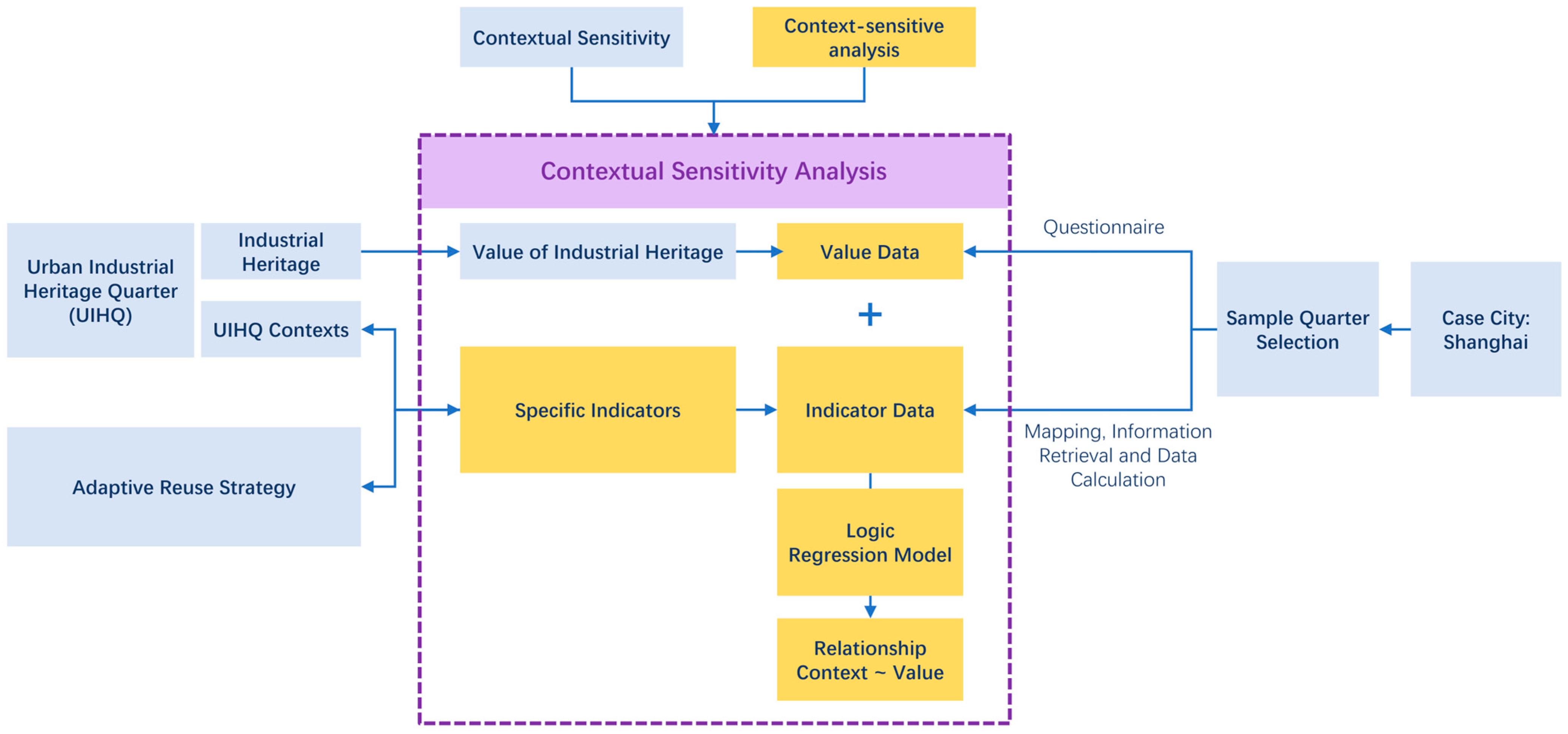



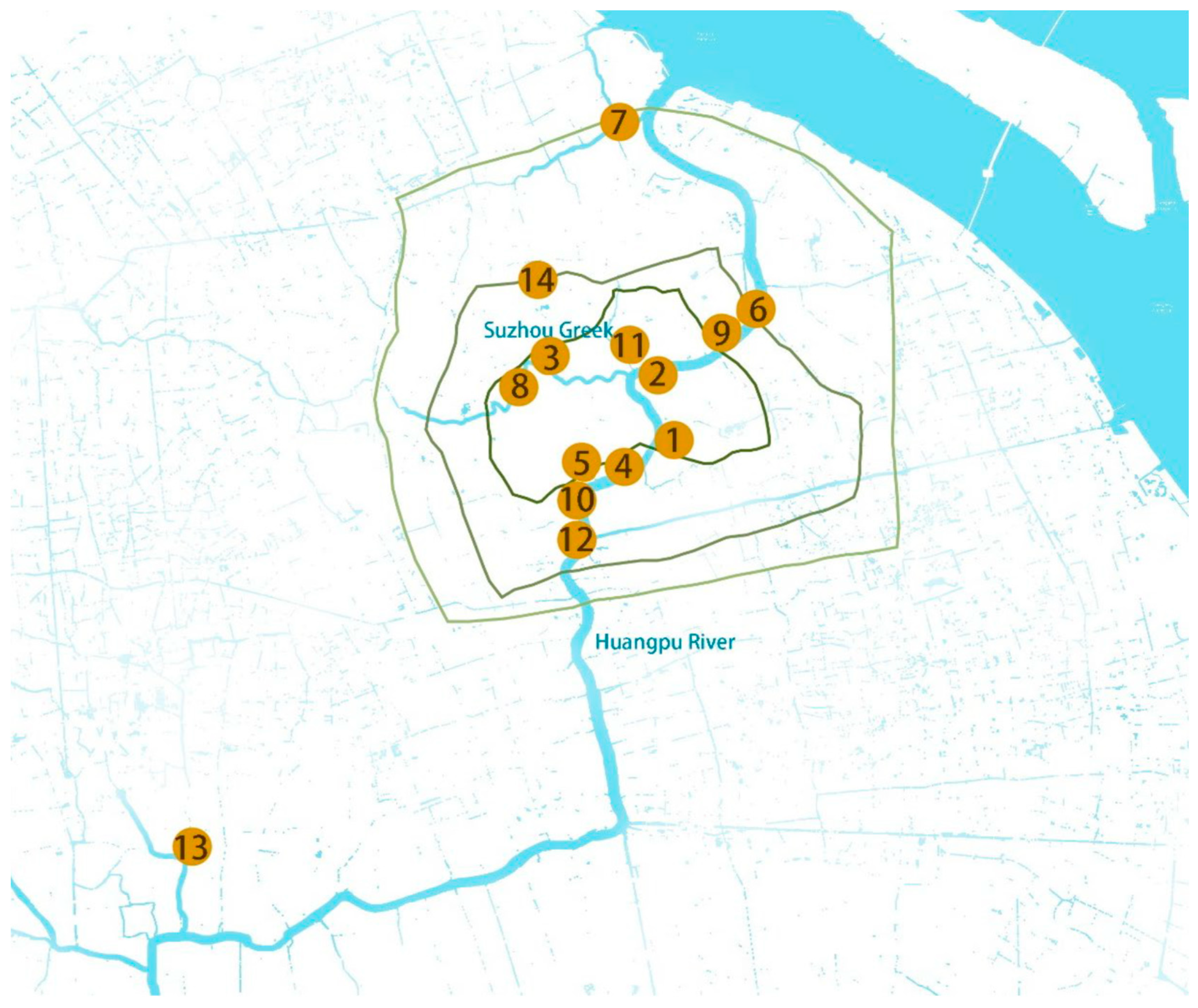

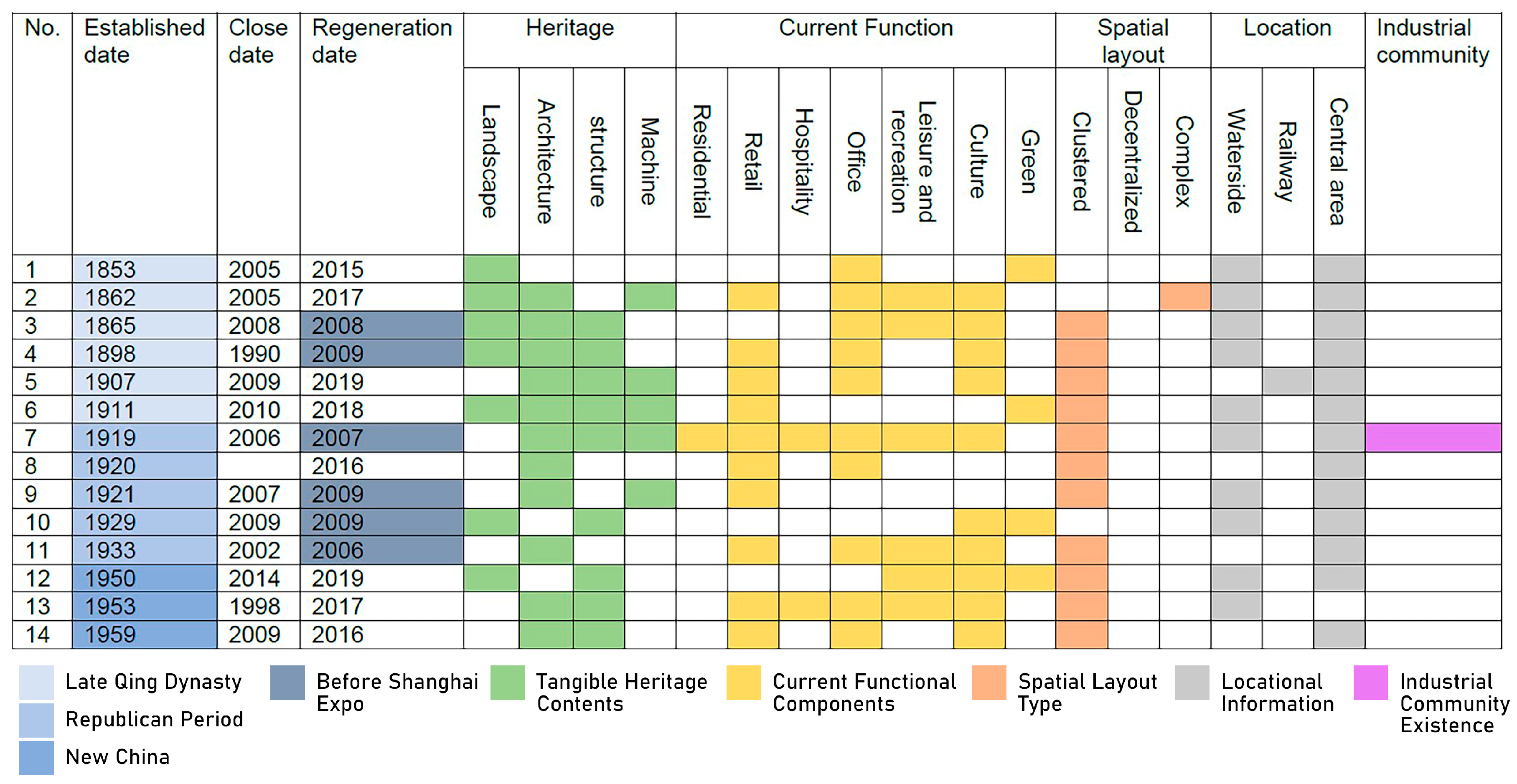







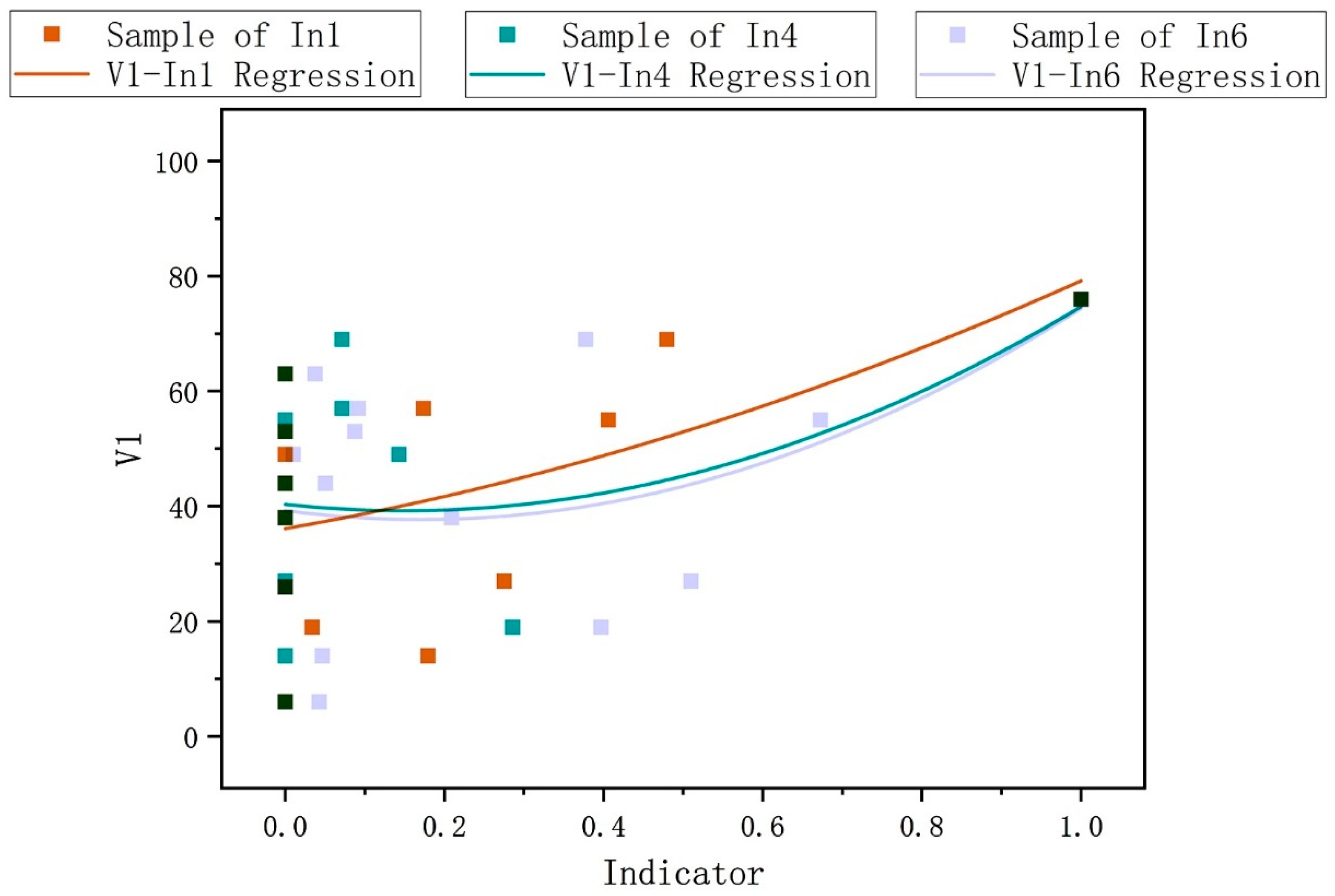
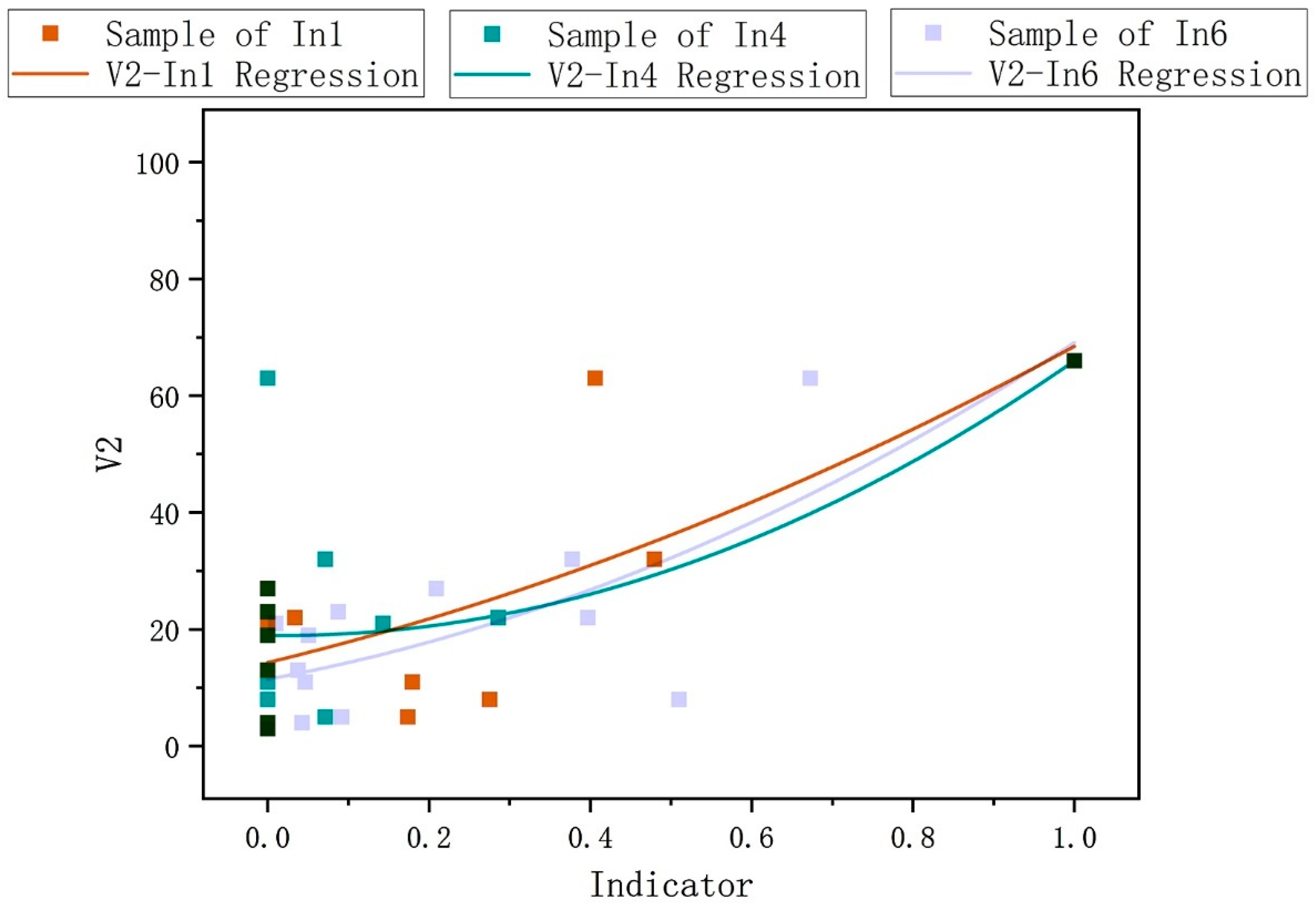
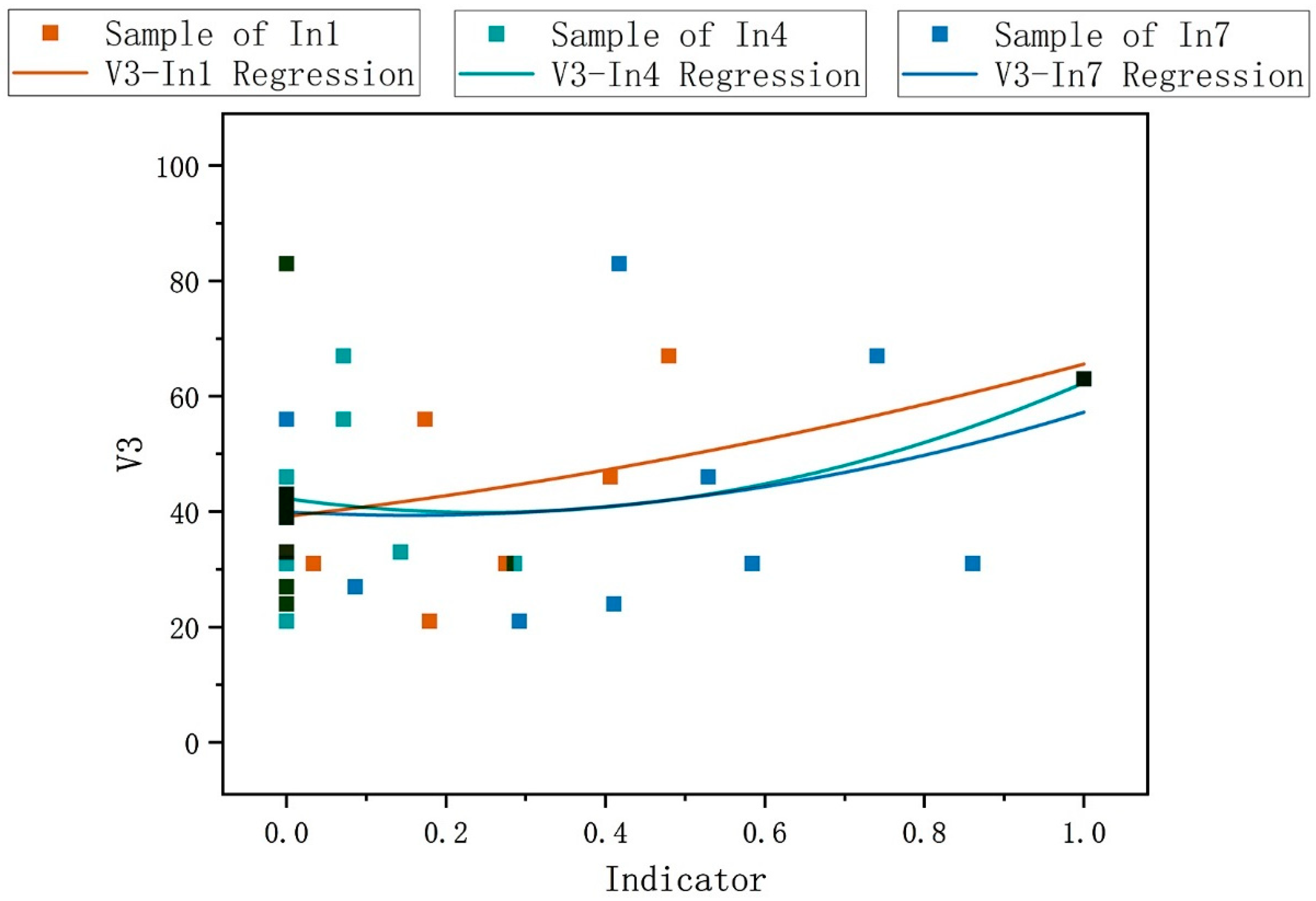

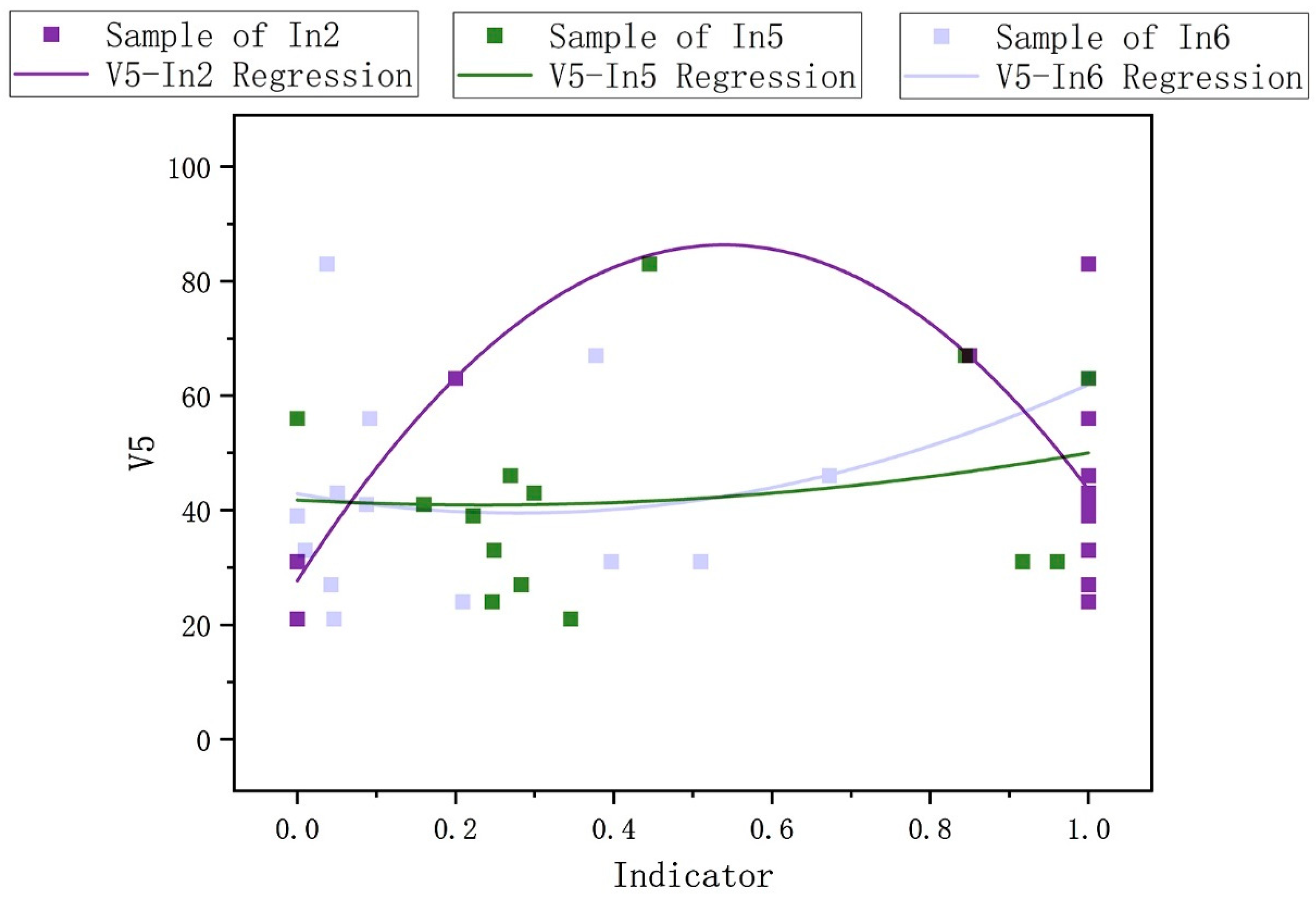
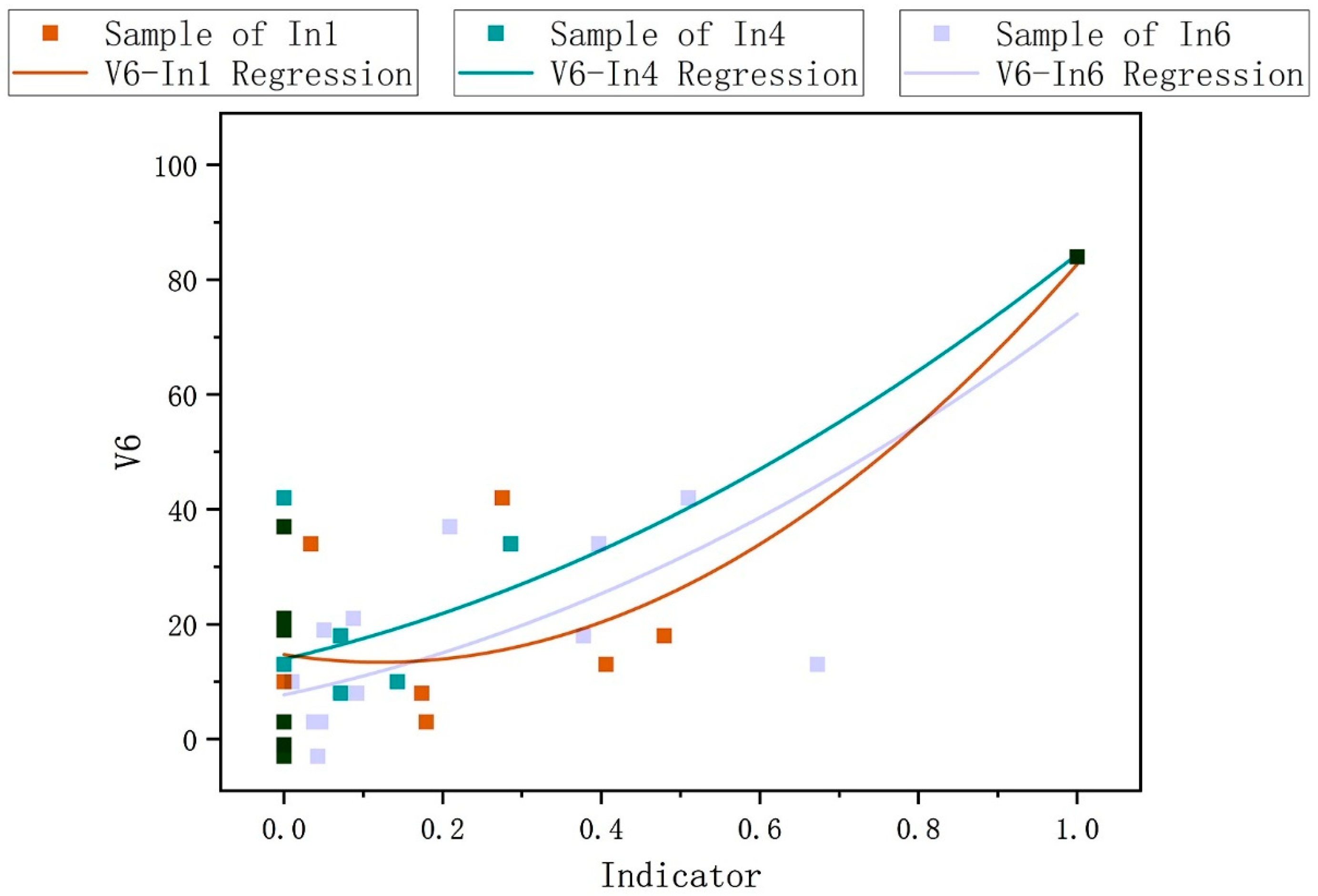
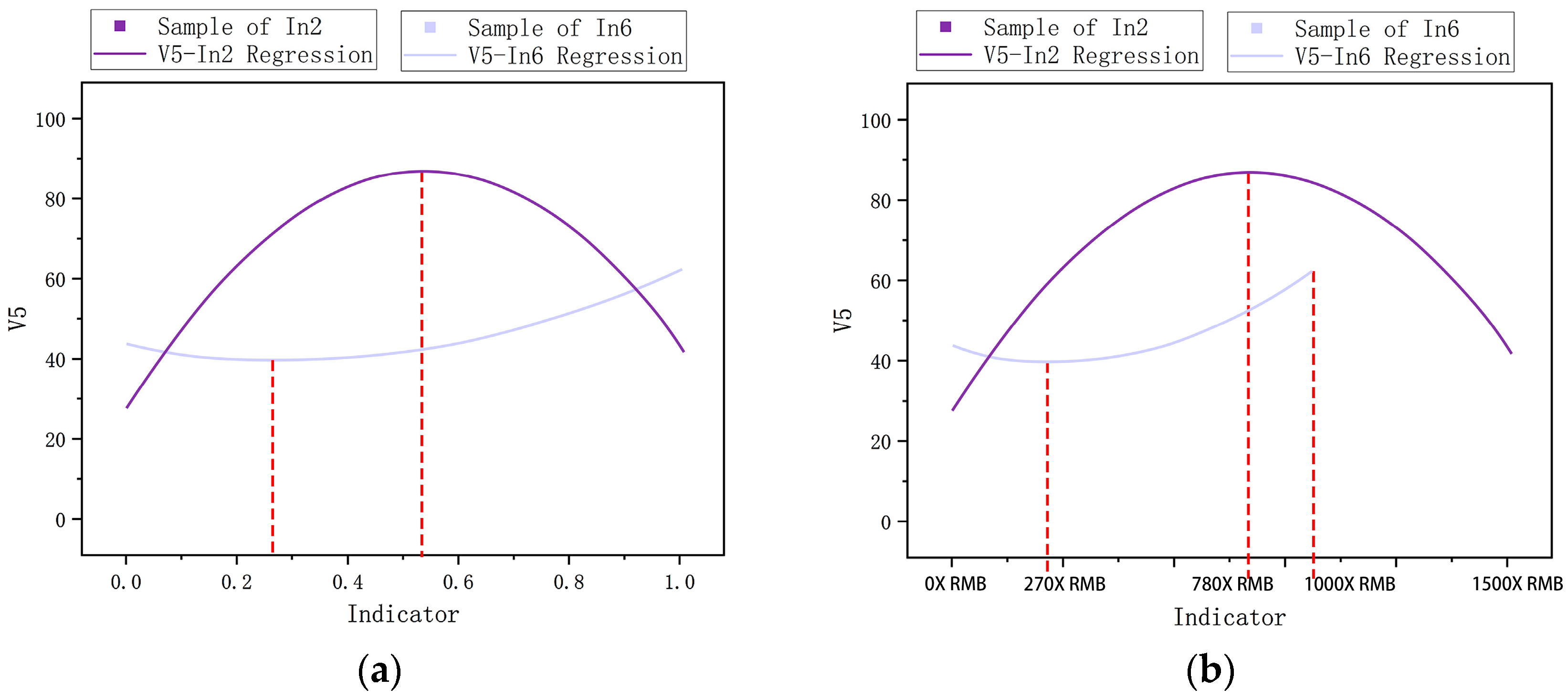
| Values | Description |
|---|---|
| V1—Historical Value | The importance and usefulness of the record relating to industrial activities that are retained for the purpose of history, including both visible and invisible pieces of evidence [35]. |
| V2—Scientific and Technological Value | The innovation and advancement of machinery, production processes, and skills in science and technology as well as the continuous influence on the development of the industry [21]. |
| V3—Socio-cultural Value | The contribution to forming place identification, connecting the lifestyle of present generations with the industrial past, and providing intangible evidence for social development [36]. |
| V4—Aesthetic Value | The beauty of industrial architecture is appreciated as a perfect combination of function and form [37], while also existing in other derivative art forms and genres such as artworks, literature, movies and films, etc., reflecting both the rational order of industrial progress, the chaotic beauty of urban decay, and the beauty of dilapidation [38,39]. |
| V5—Economic Value | The benefit generated in the process of heritage-related activities, including research, conservation, regeneration, utilization, etc. [40]. One special economic factor that industrial heritage should consider is the productivity of the original function if its original industry is still functioning. |
| V6—Natural Value | Industrial heritage that uses natural resources for transportation and energy may bring ecological system to the city with water features and greenery. The regeneration of industrial sites is also beneficial for reactivating environmental resilience and improving biodiversity [41]. |
| Value Category | Sample 1 Score: −100 to 100 (Integer) | … | Sample n Score: −100 to 100 (Integer) |
|---|---|---|---|
| Value 1 | |||
| Value 2 | |||
| Value 3 | |||
| … |
| Experts’ Category | Affiliations | Pre-Survey | Return | Scoring Table | Return |
|---|---|---|---|---|---|
| Researchers | Tongji University: The College of Architecture and Urban Planning Department of Project Management | 70 | 64 | 52 | 49 |
| Shanghai University: Fine Arts College Real Estate College | 40 | 38 | 31 | 27 | |
| Architects/urban planners | China State Construction Engineering Shanghai | 60 | 52 | 44 | 38 |
| Shanghai Academy of Urban Planning and Design | 40 | 34 | 23 | 20 | |
| Architects and urban planners from design studio | 20 | 17 | 10 | 10 | |
| Developers | Poly Real Estate | 30 | 23 | 11 | 9 |
| Vanke Real Estate | 40 | 31 | 22 | 20 | |
| Consulting/investors | JLL | 10 | 6 | 3 | 3 |
| Shanghai Industrial Urban Development Group Limited | 10 | 4 | 3 | 3 | |
| Government/ organization officers | Shanghai Planning & Nat Resources Bureau | 10 | 8 | 8 | 7 |
| Shanghai Tourism Administration | 10 | 5 | 5 | 5 | |
| Shanghai Industrial Tourism Promotion Centre | 10 | 6 | 5 | 5 | |
| Total number | 350 | 288 | 217 | 196 |
| No. | Shanghai Industrial Heritage Quarters | Regeneration Project |
|---|---|---|
| 1 | Dongjiadu Shipyard | Ferry Waterfront |
| 2 | Shanghai Shipyard—Pudong | Shipyard 1862 |
| 3 | Jiangnan Machine Manufacturing Bureau (Qiuxin Machine Shipyard) | Puxi Riverside Expo Park Area |
| 4 | Fufeng Flour Mill Xinhe Spinning Mill | M50 Creative Park |
| 5 | Shanghai Nanpu Railway Station | Station 1907 |
| 6 | Shanghai Municipal Council Electricity Department, Yangshupu Power Plant | Yangshupu Power Plant Heritage Park |
| 7 | Great China Spinning Mill and Huafeng Spinning Mill | Peninsula 1919 Cultural and Creative Industrial Park |
| 8 | Shanghai Burlap Factory | Jingyuan Fashion Industry Park The X Tower |
| 9 | Shanghai No. 17 Cotton Textile Factory | International Fashion Centre |
| 10 | Shanghai Beipiao Coal Wharf | Xuhui West Bund Waterfront |
| 11 | Shanghai Municipal Council Slaughterhouse | 1933 Old Millfun |
| 12 | Shanghai Aircraft Manufacturing Plant (5703) | West Bund Artistic Centre Oil Tank Art Centre |
| 13 | Nanmen Grain Depot | Cloud Grain Silo Cultural and Creative Industrial Park |
| 14 | Shanghai Metallurgical Mining Machinery Plant | Jing’an New Business Park |
| Number and Name of the Samples | V1 Historical | V2 Scientific and Historical | V3 Socio-Cultural | V4 Aesthetical | V5 Economic | V6 Natural | |
|---|---|---|---|---|---|---|---|
| 1 | Ferry Waterfront | 27.3 | 8.2 | 31.2 | 27.8 | 15.2 | 42.4 |
| 2 | Shipyard 1862 | 69.1 | 32.3 | 67.1 | 40.9 | 72.9 | 17.8 |
| 3 | Puxi Expo | 54.9 | 62.7 | 45.8 | 49.3 | 26.3 | 12.9 |
| 4 | M50 Creative Park | 63.4 | 12.6 | 82.8 | 29.1 | 63.1 | 3.1 |
| 5 | Station 1907 | 57.1 | 5.1 | 55.7 | 67.5 | 67.2 | 8.4 |
| 6 | Yangshupu Power Plant | 75.7 | 66.4 | 63.3 | 81.5 | 25.7 | 84.3 |
| 7 | Peninsula 1919 | 49.8 | 21.2 | 33.1 | 36.4 | 40.5 | 10.2 |
| 8 | Jingyuan & The X | 6.2 | 3.7 | 27.2 | 15.1 | 51.1 | −2.9 |
| 9 | International Fashion Center | 37.8 | 27.1 | 24.4 | 25.8 | 76.4 | 37.1 |
| 10 | Xuhui Waterfront | 19.2 | 22.3 | 31.2 | 73.2 | 18.3 | 33.8 |
| 11 | 1933 Old Millfun | 26.3 | 3.3 | 38.7 | 46.2 | 13.7 | −1.1 |
| 12 | West Bund & Oil Tank | 14.3 | 10.6 | 21.2 | 27.4 | 24.1 | 3.1 |
| 13 | Cloud Grain Silo | 52.7 | 23.4 | 41.1 | 61.9 | 57.2 | 21.4 |
| 14 | Jing’an New Business | 44.1 | 19.1 | 43.4 | 34.3 | 39.2 | 18.8 |
| No. | Sample | In1 | In2 | In3 | In4 | In5 | In6 | In7 |
|---|---|---|---|---|---|---|---|---|
| 1 | Ferry Waterfront | 0.121859 | 0 | 0.13 | 0 | 0.300853 | 0.259697 | 0.305806 |
| 2 | Shipyard 1862 | 0.212359 | 0.85 | 0 | 1 | 0.269487 | 0.192282 | 0.387892 |
| 3 | Puxi Riverside | 0.17975 | 1 | 0.85 | 0 | 0.020418 | 0.342501 | 0.276923 |
| 4 | M50 Creative Park | 0 | 1 | 1 | 0 | 0.096492 | 0.01918 | 0.218459 |
| 5 | Station 1907 | 0.076982 | 1 | 0.63 | 1 | −0.09631 | 0.046754 | 0 |
| 6 | Yangshupu Power | 0.442883 | 0.2 | 0.5 | 14 | 0.336973 | 0.509409 | 0.523729 |
| 7 | Peninsula 1919 | 0 | 1 | 1 | 2 | 0.011429 | 0.005043 | 0 |
| 8 | Jingyuan Fashion | 0 | 1 | 0 | 0 | 0.026295 | 0.021633 | 0.045093 |
| 9 | International Fash | 0 | 1 | 0 | 0 | 0.010359 | 0.106496 | 0.215 |
| 10 | Xuhui West Bund | 0.01498 | 0 | 0.83 | 4 | 0.319968 | 0.202119 | 0.450658 |
| 11 | 1933 Old Millfun | 0 | 1 | 0 | 0 | 0 | 0 | 0 |
| 12 | West Bund Artistic | 0.079401 | 0 | 0.71 | 0 | 0.053507 | 0.023733 | 0.152889 |
| 13 | Cloud Grain Silo | 0 | 1 | 1 | 0 | −0.02696 | 0.044604 | 0 |
| 14 | Jing’an New | 0 | 1 | 0.25 | 0 | 0.033472 | 0.025672 | 0 |
| Value | In1 | In2 | In3 | In4 | In5 | In6 | In7 |
|---|---|---|---|---|---|---|---|
| V1 | 0.54239 | 0.29941 | 0.27725 | 0.40759 | 0.10635 | 0.40005 | 0.25758 |
| V2 | 0.74328 | −0.08021 | 0.20842 | 0.61181 | 0.34534 | 0.81695 | 0.60784 |
| V3 | 0.3966 | 0.26145 | 0.20588 | 0.27627 | 0.18433 | 0.22743 | 0.2658 |
| V4 | 0.48312 | −0.22627 | 0.3739 | 0.66443 | 0.26985 | 0.51251 | 0.36045 |
| V5 | −0.1823 | 0.60744 | −0.07331 | −0.24795 | −0.34981 | −0.31995 | −0.20005 |
| V6 | 0.69941 | −0.50987 | −0.07469 | 0.80438 | 0.67343 | 0.80862 | 0.69893 |
Disclaimer/Publisher’s Note: The statements, opinions and data contained in all publications are solely those of the individual author(s) and contributor(s) and not of MDPI and/or the editor(s). MDPI and/or the editor(s) disclaim responsibility for any injury to people or property resulting from any ideas, methods, instructions or products referred to in the content. |
© 2025 by the authors. Licensee MDPI, Basel, Switzerland. This article is an open access article distributed under the terms and conditions of the Creative Commons Attribution (CC BY) license (https://creativecommons.org/licenses/by/4.0/).
Share and Cite
Li, S.; Heath, T. Contextual Sensitivity Analysis for Urban Industrial Heritage Quarter Regeneration: Shanghai as a Pilot Case Study. Heritage 2025, 8, 190. https://doi.org/10.3390/heritage8060190
Li S, Heath T. Contextual Sensitivity Analysis for Urban Industrial Heritage Quarter Regeneration: Shanghai as a Pilot Case Study. Heritage. 2025; 8(6):190. https://doi.org/10.3390/heritage8060190
Chicago/Turabian StyleLi, Simiao, and Tim Heath. 2025. "Contextual Sensitivity Analysis for Urban Industrial Heritage Quarter Regeneration: Shanghai as a Pilot Case Study" Heritage 8, no. 6: 190. https://doi.org/10.3390/heritage8060190
APA StyleLi, S., & Heath, T. (2025). Contextual Sensitivity Analysis for Urban Industrial Heritage Quarter Regeneration: Shanghai as a Pilot Case Study. Heritage, 8(6), 190. https://doi.org/10.3390/heritage8060190







